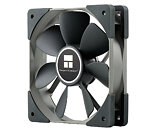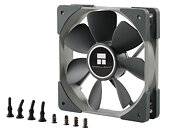Friday, May 15th 2020
Thermalright Intros TY-121BP FDB Low Impedance Fans
Thermalright introduced the TY-121BP FDB, a 120 mm case fan optimized for circulation applications. Built in a standard 25 mm-thick 120 mm format with rubberized frame mounts. The package includes rubber bolts in addition to metal screws. The fan features a long life (>40,000-hours rated) fluid-dynamic bearing. Taking in 4-pin (PWM) input, it spins between 600 - 1,800 RPM pushing 25.76 CFM of air at its lowest speed, and 77.28 CFM at top speed, with up to 2.70 mm H2O air-pressure. The noise output proportionately ranges between 19 to 25 dBA. The fan is currently selling in single-piece packages priced at $20, multi-fan packs are also in the works.




29 Comments on Thermalright Intros TY-121BP FDB Low Impedance Fans
I'm no rocket surgeon, but that fan pitch looks too aggressive to be optimized for static pressure.
Edit: It's not even listed on their website!
- They look like airflow-optimised fans
- The article says they are circulation fans for case airflow, not static-pressure fans.
Why, exactly, did you bring static pressure into this at all?Fan Dimensions: W120 mm x D120 mm x H25.4 mm
Fan Speed: 600~1800 RPM±10%
Air Flow: 25.76~77.28 CFM
Air Pressure: 0.30~2.72 mm H2O
Noise Level: 19~25 dBA
Weight: 1178 g
Radiator:Aluminum
Warranty: 2 Years
2.72mm H2O is surprisingly good.
Nice to see them in the running again.
But it's sucks, powerful enough but noisy.
Thermalright's fan going to take on the NF-A12x25 has been launched for years, it's TL-C12 thermalright.com/product/tl-c12/ . It's almost the same with A12x25, performance and sound.
I use 5 of them.Not quite, the Noctua NF-S12A is 33,84 CFM at 600 RPM and 6.7 dB(A).
Is this even real!
TY-121BP's shape has been for years, check when Macho120 was launched. It's improved by X-silent 120, this shape even can pass through the 27mm radiator. And then check your proud S12A, is it can?
Or are they using terrible marketing to describe some other physical attribute as "low impendance"? Like, it has low impedance to airflow? Let's hope they aren't that dim.
As you say, low electrical impedance would be bad. As, thinking about it, would acoustic impedance. You'd want high acoustic impedance to keep noises in your case from escaping past the fan to the oustide.
High impedance fans don't cater to the noise consciencious market. There is no relativite ground in this measure. If it is high impedance, you have the turbulence.
Also, high impedance destroys the image of the coolers. Once you push more air, the flow cross-section becomes turbulent and a competitive noise race with blade servers starts. Very funny to notice this, it totally limits fan preferences.
Using the term "low impedance" or "high impedance" to describe a PWM fan's air flow is STUPID. That's the problem.
Couldn't they use any other term? What's wrong with static pressure or CFM or any other already available measure of airflow?
PWM is an electronic feature. High impedance, or low impedance, is an electronic design characteristic. Stating "Low impedance PWM fan" literally states that it uses a low impedance PWM circuit; which is electrically terrible for this purpose. Literally. Like, you know, this is English, and that is what they wrote. That's also terrible; to destroy the meaning of words. Electrical impedance is very important ... why devalue it by using it to describe airflow?
Can't they use any other less misleading marketing terminology?